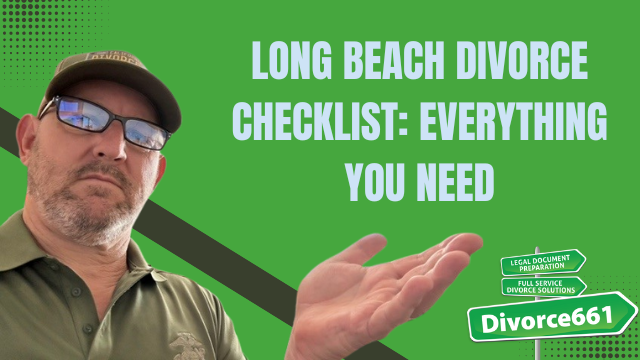Long Beach Divorce Checklist: Everything You Need
Overview
Filing for divorce in Long Beach means working through the Los Angeles County Superior Court system. That court requires electronic filing and enforces strict formatting and document rules. A single missing disclosure or improperly formatted document can delay your case or lead to rejected paperwork. This checklist walks through each step and the specific documents you need to move a Long Beach divorce through to final judgment as smoothly as possible.
Where to file and key court rules
Long Beach is part of Los Angeles County, so all divorce filings must go through the LA Superior Court. Important things to keep in mind:
- E-filing is required. Every document must meet the court’s formatting and filing instructions.
- Follow local rules closely. Rejections are common when forms are incomplete, unsigned, or misformatted.
- Deadlines matter. Timely exchanges and filings keep you out of unnecessary motion hearings.
Step 1: Initial filing — the documents to start your case
To open a divorce case, prepare and file these core documents:
- Petition for Dissolution (Form FL-100 or local equivalent) — starts the case and sets legal requests for property, support, custody, etc.
- Summons (Form FL-110) — notifies the other party they have a legal action against them and explains deadlines.
- UCCJEA (Form FL-105) — if you have children, this form outlines the children’s prior addresses and helps the court determine jurisdiction.
Step 2: Serving your spouse
After filing, your spouse must be properly served. Two common options:
- Personal service — a third party (usually a process server or sheriff) physically delivers the documents and completes a proof of service.
- Notice of Acknowledgement of Receipt — the spouse signs this form to acknowledge they received the papers, which can avoid hiring a process server.
Always confirm service is recorded correctly. Improper service is a frequent reason courts set aside or delay proceedings.
Step 3: Financial disclosures — exchange everything
Both parties must complete and exchange financial disclosures. These are required even when you agree on terms:
- Schedule of Assets and Debts (Form FL-142 or local equivalent) — itemizes property, accounts, debts, and values.
- Income and Expense Declaration (Form FL-150) — documents income, monthly expenses, and deductions.
- Any supporting documents: pay stubs, tax returns, bank statements, retirement account statements, deeds, and mortgage statements.
The court relies on accurate disclosures to approve settlements. Missing or incomplete disclosures are one of the top causes of rejected final judgments.
Step 4: Drafting a settlement agreement
If you and your spouse can agree on terms, prepare a comprehensive settlement agreement that covers:
- Division of community and separate property
- Spousal support (if any)
- Child custody, visitation, and child support
- Responsibility for debts
- Procedure for disputes or modifications
A well-drafted agreement reduces the need for court appearances and speeds finalization. Make sure the agreement is signed and dated by both parties and matches the numbers and disclosures in the financial paperwork.
Step 5: The judgment package — what the court needs to finalize your case
To obtain a final judgment you’ll submit the judgment package. Common items include:
- Judgment form (usually FL-180 or local judgment forms)
- Signed settlement agreement or marital settlement document
- Proofs of service and signed acknowledgements
- Completed and exchanged financial disclosures
- Any required local attachments or forms mandated by Los Angeles County
Double-check that all signatures are present and that the court’s formatting and filing requirements are met. Courts will reject judgments that omit required disclosures or include mismatched figures.
Common pitfalls — real example and lessons learned
Missing a single disclosure can create major delays. In one case, a couple thought they had everything in order but missed a required disclosure form. Their judgment was rejected twice. A full file review corrected the omission and the judgment was finalized within a week.
Key lessons:
- Use a checklist to verify every required form is included before filing final paperwork.
- Keep copies of everything and ensure numbers line up across documents.
- When in doubt, run a complete file review before submitting the judgment to court.
How a checklist-based service helps
A proven checklist system tailored to your county reduces errors and rejections. Practical benefits include:
- Step-by-step guidance for e-filing in Los Angeles County
- Document preparation and formatting to court standards
- Review of financial disclosures to ensure completeness
- Preparation and submission of the final judgment package
Using a checklist-based approach ensures nothing falls through the cracks and minimizes the chance of having your judgment rejected or delayed.
Long Beach divorce quick checklist
- Confirm filing location: Los Angeles County Superior Court and e-filing requirements.
- Prepare initial forms: Petition, Summons, UCCJEA (if children).
- Serve your spouse by personal service or signed acknowledgement.
- Exchange financial disclosures: Schedule of Assets and Debts, Income and Expense Declaration, and supporting documents.
- Draft and sign a complete settlement agreement addressing property, support, and custody.
- Assemble the judgment package with all signed documents and proofs of service.
- Run a final checklist review to verify formatting, signatures, and consistency before e-filing.
Final note
Filing for divorce in Long Beach does not have to be confusing or slow. Follow a clear, county-specific checklist, document everything, and verify all disclosures before submitting the final judgment. That extra attention up front saves time, expense, and frustration down the road.

